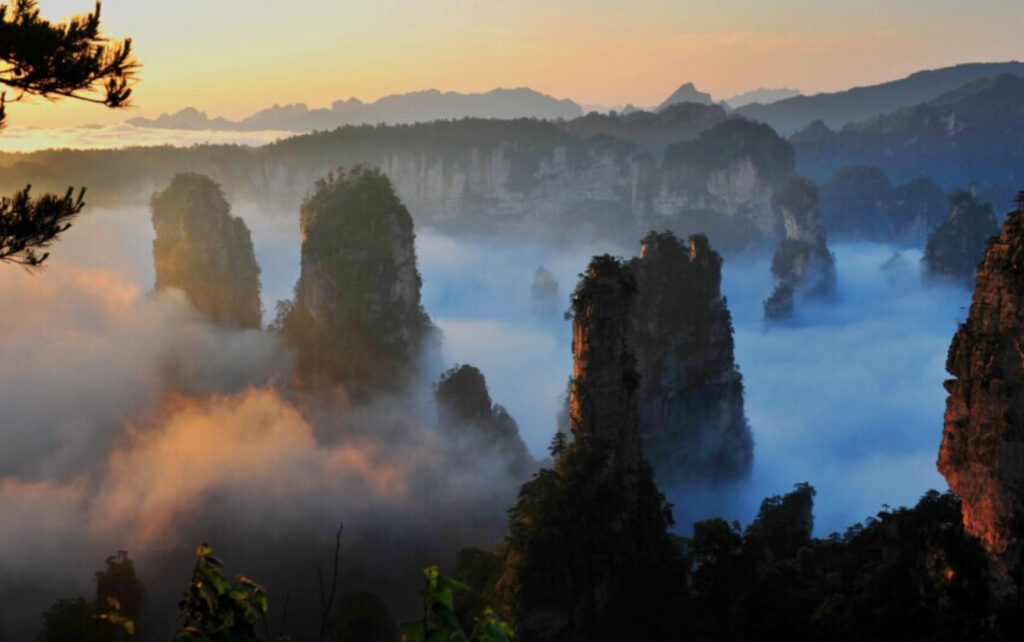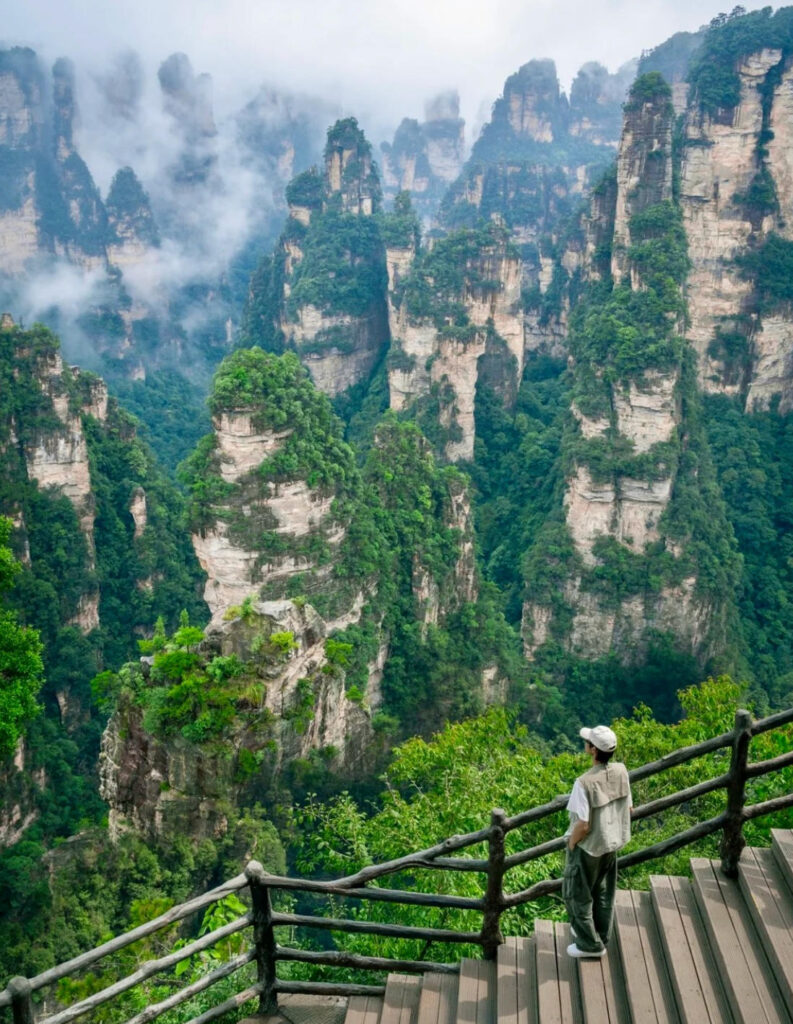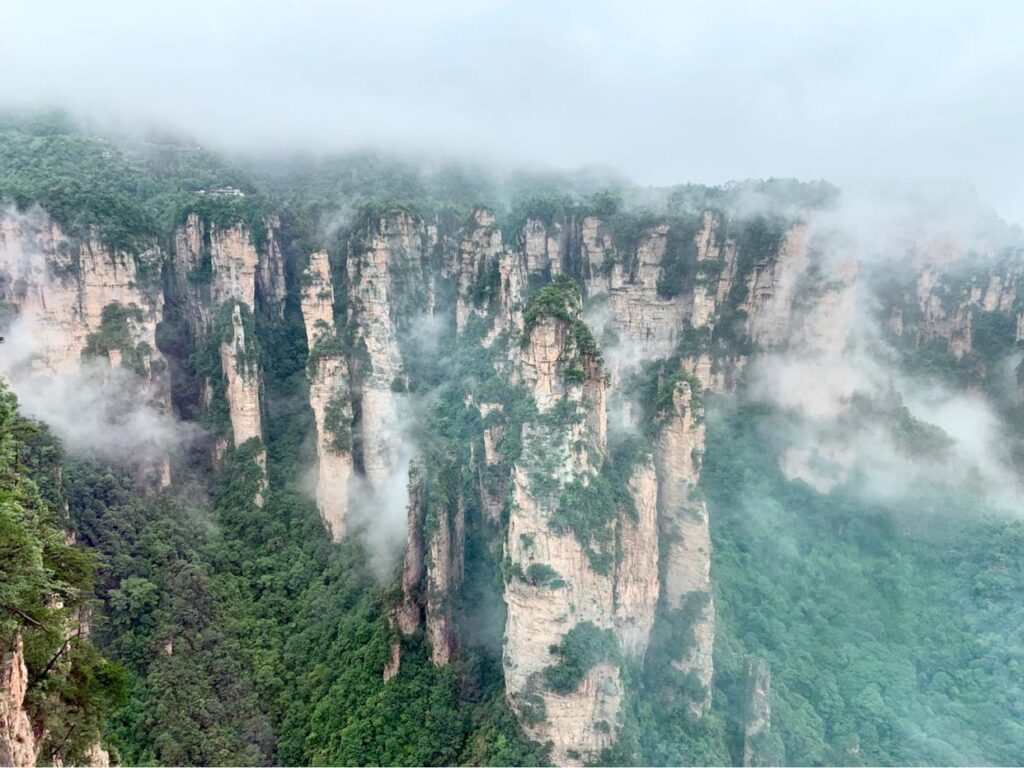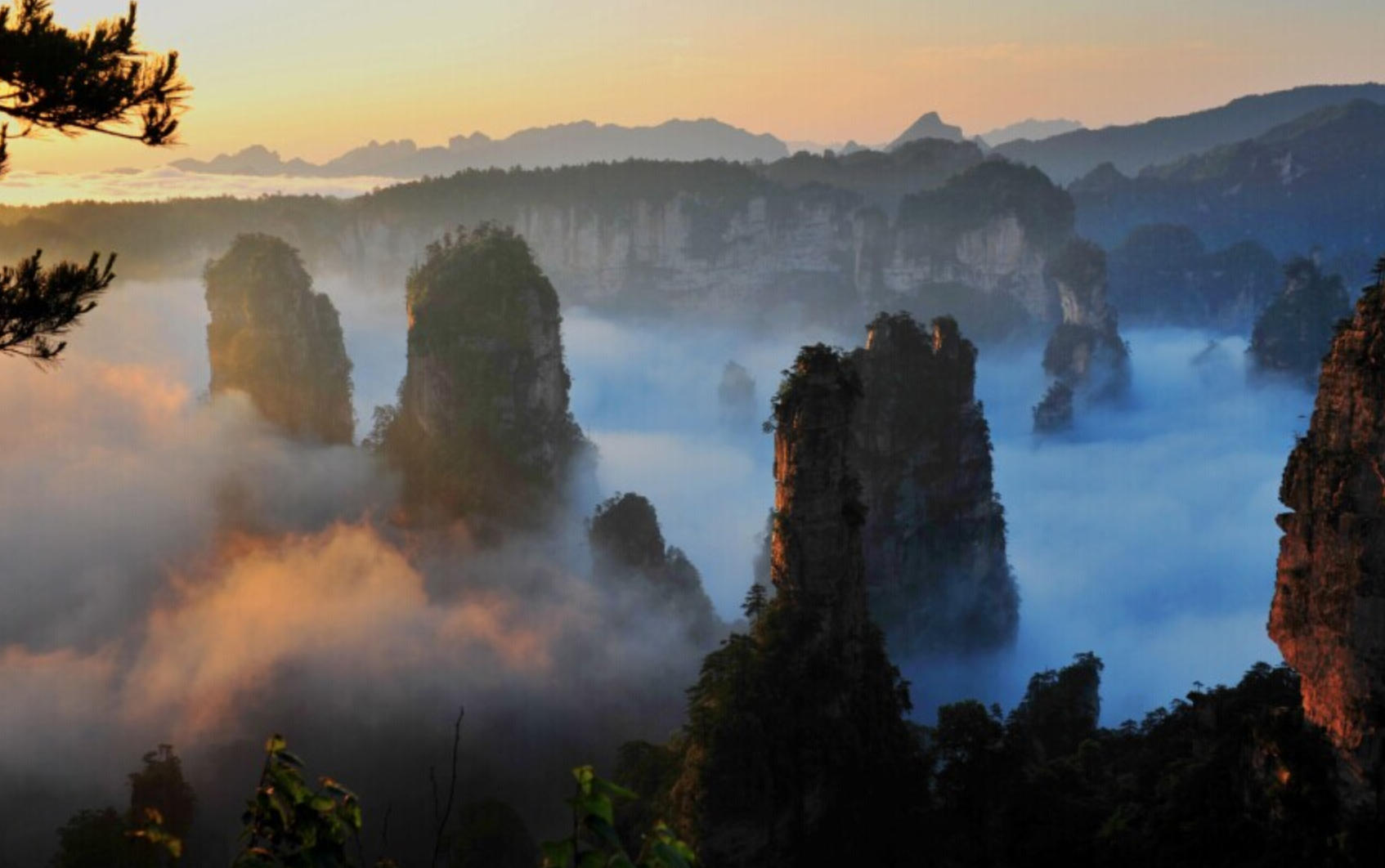Zhangjiajie National Forest Park covers an area of 130 square kilometers and is China’s first national forest park. It is in the early stage of peak forest evolution, featuring unique landforms with towering stone peaks of diverse shapes and lush vegetation. Surrounded by mountains with steep slopes and deep ravines, the park enjoys a warm and humid climate and boasts numerous scenic attractions. Within its boundaries lie two broad, flat-topped, steep-sloped mountains exceeding 1,000 meters in elevation: Huangshizhai and Yaozizhai. Geomorphologically, these flat-topped mountains remain in the early stage of peak forest evolution. Their broad, hard rock formations, coupled with surrounding cliffs composed of vertical joint planes, create towering, majestic fortresses with expansive, level summits—evoking a sense of awe-inspiring grandeur. Zhangjiajie National Forest Park is divided into six smaller scenic areas: Huangshizhai, Pipaxi, Jinbianxi, Yaozizhai, Shedaogou, and Yuanjiajie.

Huangshizhai is the most renowned scenic area within Zhangjiajie National Forest Park, famously described as “If you haven’t been to Huangshizhai, you haven’t truly been to Zhangjiajie.”

Legend has it that Huang Shi Gong, the master of Zhang Liang, once came here to refine elixirs, hence the name Huangshizhai. Located in the central part of the park, it is a massive square mountain plateau at an altitude of 1,080 meters, with a summit area of 16.5 hectares. It is considered the most beautiful viewing platform in Wulingyuan. Ascending this natural observation deck, one is greeted by countless jagged stone peaks and pillars, densely clustered to form a vast forest of peaks. The sight fills the heart with boundless joy and wonder. When shrouded in a sea of clouds, the peaks appear draped in white veils, their rugged forms appearing and disappearing amidst the ethereal mist, shifting in an instant.
The area features over 20 major attractions, including the Heavenly Book Treasure Chest, Southern Sky Pillar, Natural Murals, Star-Picking Terrace, Black Pine Ridge, Remnant of the Sky Bridge, and Mandarin Duck Spring.
Must-See Scenery
Heavenly Book Treasure Chest
The Heavenly Book Treasure Box is a renowned attraction within Zhangjiajie National Forest Park. Located on the lower right side of the entertainment platform on the front mountain of Huangshizhai, a circular stone pillar stands alone. Its summit features two overlapping stone slabs—one thin, one thick—resembling a book box with its lid partially lifted. Folklore claims this relic was abandoned by the ancient Xiangwang Emperor, hence its name.
Pillar of the Southern Sky:The Call of Avatar: The Hallelujah Mountains

The floating “Hallelujah Mountains” in James Cameron’s Avatar were not purely fictional—their inspiration came from here. In the Yuanjiajie scenic area, you will find the towering pillar named “Southern Sky Column,” now a world-famous bridge between fantasy and reality.
On January 25, 2010, Zhangjiajie’s South Heavenly Pillar was renamed “Hallelujah Mountain” from the film Avatar. It is understood that numerous landscapes in the movie’s “Pandora” world were inspired by Zhangjiajie’s mountains, with images of the South Heavenly Pillar serving as the prototype for the floating Hallelujah Mountain.
Natural Mural
Near the summit of Huangshizhai in Zhangjiajie National Forest Park, looking eastward, one can see the weathered textures and scattered shrubs and bushes on the western cliff face of Yaozizhai, a kilometer away. Together, they form a natural mural brimming with the rustic charm of Tujia folk culture.
Star-Gazing Terrace
At the eastern edge of Huangshizhai Peak, a 100-meter ridge extends outward. At its terminus sits a viewing platform formed by two stacked sandstone slabs.
Heizongnao
Heizongnao, located at the northern edge of Huangshizhai’s plateau within Zhangjiajie National Forest Park, derives its name from the dense stand of dark fir trees covering its surface. This elusive sight stands inaccessible, towering over a deep, secluded gorge. The plateau’s sides are steep as if cut by a blade, covered in tall, lush pine forests and diverse hardwoods, forming a vast expanse of dark, primeval woodland.
Sky Bridge Ruins
The Sky Bridge Ruins lie beneath the northwestern cliff edge of Huangshizhai in Zhangjiajie Forest Park. Over 60 elliptical stone pillars, each over 200 meters tall, stand in a north-south line across a 3,000-meter-long valley between Huangshizhai and Yuanjiajie.
Mandarin Duck Spring
Commonly known as White Sand Well, Mandarin Duck Spring lies where the Huangshizhai trail meets the Huaxiyu scenic route. Nestled in a secluded setting beneath towering trees, the spring water gathers into a well whose crystal-clear depths reveal a bed of white sand as pure as crushed silver. Renowned for its excellent quality, the water is refreshingly sweet to drink. A folk rhyme goes:
When chives bloom with fine, downy flowers,
A heart set on a lover fears no poverty.
As long as two hearts are true,
Cold water brews tea, slowly growing rich.
Three Sisters Peaks
About 2 kilometers southwest of Husband-Wife Rocks stand three stone peaks spaced roughly 80 meters apart, resembling three graceful maidens. Legend holds that these were once Flower Fairies who defied the Dragon King of the South Sea to aid mountain villagers, only to be transformed into peaks.
Reunion Across a Thousand Miles
Following the stream eastward from Purple Grass Pool and rounding a mountain bend, two peaks emerge amidst the scattered ridges to the southeast. They stand facing each other like long-separated spouses gazing tenderly. The husband, towering and imposing, wears a helmet and armor with a long sword at his waist. As if returning from afar, he stands slightly stooped, head bowed, comforting his wife. She, with a graceful and full figure, wears long hair and exudes charm. Her left arm encircles his waist, her face slightly upturned. The two gaze tenderly at each other, clinging closely as if whispering secrets, sharing the pain of separation. They appear as a long-separated couple reunited after a thousand miles apart.
The Divine Needle of Dinghai
Looking eastward from the eastern section of Huangshizhai’s mountain trail, a peak rises hundreds of meters from the emerald valley below, draped like a brocade. Its summit is covered in shrubs like jade, while its grayish-white walls shimmer brilliantly in the sunlight. During rainy days, the valley churns with clouds and mist like raging ocean waves. This peak stands like a pillar in the midst of the storm, towering above the clouds and mist, unshakable and indestructible—thus earning its name. A hundred meters to its southwest, another peak resembles a monkey’s head, its neck retracted and fist clenched as if peering down, like Sun Wukong poised to seize this Sea-Anchoring Pillar. Turning right along the trail and gazing into the mountain ravine, one sees a conical stone peak over a hundred meters tall, pointed at the top and blunt at the base. At dawn and dusk, it often appears and disappears amidst the mist and clouds, resembling the Divine Needle that Sun Wukong encountered while exploring the Dragon Palace. Hence, it is named “Divine Needle.”
South Heavenly Gate
On the southeast slope of Huangshizhai Mountain, a sloping rock peak spanning over ten square meters arches with a thousand-fold stone wall to form a gate, opening southward. The stone path winds through this narrow, deep archway. Wild trees cluster on either side, while outside, clouds and mist swirl in a majestic display reminiscent of the mythical South Heavenly Gate. More astonishingly, a peculiar rock formation resembling a human figure rises about 20 meters tall from the right side of the gate. Its imposing, stern stance evokes the image of a guardian general standing sentinel at the heavenly pass.
Huangshizhai Cableway
The Huangshizhai Cableway spans a diagonal length of 973 meters with an elevation difference of 430 meters. Jointly developed by Zhangjiajie National Forest Park Management Office and Taiwan’s Ruizhan Company, it operates as a single-car, single-haul reversible cableway system. Its primary electromechanical equipment was imported from France’s POMA company. Since commencing operations in 1997, it has served nearly 10 million visitors and successfully accommodated state leaders on multiple occasions. The company has successively obtained ISO9001, ISO14001, and GB/T28001 management certifications. In March 2005, during the China Ropeway Association’s national “Top Ten Ropeways” selection campaign themed “People-Oriented, Safety First, Building China’s Renowned Ropeway Brands,” the Huangshizhai Ropeway was ranked first among the national “Top Ten” by the selection committee and ropeway expert panel based on its comprehensive score.
【Legend of Huangshizhai】
The origin of Huangshizhai’s name traces back to Zhang Liang, Marquis of Liu during the Han Dynasty. After retreating to Qingyanshan in Zhangjiajie, Zhang Liang devoted himself to alchemy and immortality practices. One day, villagers from the foothills reported that the Prefect of Wuling Commandery had received a secret edict from Empress Lü to arrest him. Enraged, Zhang Liang discarded his alchemy flask. Leading his disciples and villagers, he carried provisions, drove pigs, sheep, and oxen, and rushed straight to the highest and largest peak of Qingyan Mountain. There, he established a fortified camp, erected barriers, forged weapons and arrows, and vowed to fight the Wuling Prefect to the death. Within days, the prefect indeed arrived with three thousand troops to besiege the mountain stronghold. Zhang Liang defended the fortress from its strategic heights. With fortified passes, rolling boulders, and flying arrows, he repelled the governor’s forces, who dared not approach the edges. After forty-nine days of siege, they still could not breach the defenses or capture Zhang Liang. Frustrated, the governor ordered trees felled and dry grass spread, attempting a fire attack. But the sheer cliffs proved too high for the flames to climb, and the assault failed. Eager for his reward, the governor refused to withdraw. In the blink of an eye, he ordered his troops to encircle the mountain, laying siege for three full months, hoping to starve Zhang Liang’s men to death.
This tactic proved devastating. The provisions hauled up the mountain were consumed, the pigs and sheep slaughtered. Finally, they were forced to kill the oxen for food. When everything edible was gone, Zhang Liang ordered his men to gather the bones of pigs, cattle, and sheep. They burned them in fires, ground them into powder, and mixed it with water to drink. Eventually, even the bones were exhausted. With nothing left to eat, some men collapsed from starvation, unable to rise. In this moment of dire peril, Zhang Liang recalled the Yellow Stone Sage who had gifted him the military treatise. Only by seeking his master’s guidance could they be saved. He lit incense, candles, and paper offerings, knelt on both knees, and bowed toward the heavens, imploring his teacher. Strangely enough, after completing three bows, a wisp of white smoke suddenly rose from the ground. Within the smoke appeared an old man with a white beard, holding a whisk. He waved it a few times in the air before slowly retreating back into the mist. When the smoke cleared, the old man vanished. Zhang Liang remained kneeling, bewildered by the encounter. Suddenly, someone rushed over, ecstatic with joy: “Three carp have leaped out of the three small ponds on the mountain! Each weighs over eighty jin!” Zhang Liang was utterly perplexed. How could ponds barely larger than cattle wallows produce such fish? How could carp weighing over eighty jin leap from such ponds? He hurried to investigate. Sure enough, three enormous fish were being carried ashore by the men. His starving disciples, eyes gleaming with hunger, exclaimed joyfully, “Master! We’re all famished! Let’s cook these carp and eat them!” Zhang Liang pondered for a moment, then shook his head firmly. “No!” The brothers stared wide-eyed in astonishment. “What? We can’t eat these fish?”
Zhang Liang offered no explanation. With a commanding gesture, he pointed and ordered, “Toss all three fish off the cliff!” The starving men, nearly fainting from hunger, would have gladly bitten into the raw fish. Yet when Zhang Liang flung them over the edge, none understood why. Daring not disobey, they lifted the three fresh carp and staggered toward the cliff, flinging them down one after another. The fish landing below startled the surrounding soldiers, who rushed to report to the prefect. When the prefect arrived to investigate, his face drained of color like a pig’s bladder punctured by a needle, deflating instantly. He stood limp and disoriented, waving his hand weakly. “Lift the siege. Withdraw…” The soldiers murmured in disbelief, “Why lift it?” The governor sighed, “How could we possibly starve someone to death with only seventy or eighty pounds of carp left in the fort?” The defenders on the cliff, seeing the governor’s troops retreat, reported the news to Zhang Liang with both shock and delight. Zhang Liang exclaimed joyfully, “You don’t know—it was my master, the Yellow Stone Sage, who bestowed the Heavenly Fish upon me to save the day!” Only then did his brothers realize the truth, deeply admiring Zhang Liang’s great wisdom and strategy. After the storm passed, the people of Qingyan Mountain returned to their peaceful, prosperous lives. To honor his mentor, Zhang Liang named the nameless mountain stronghold Huangshi Village.
【Important Notes】
1. Before visiting Huangshi Village, it’s best to research and compare information online.
2. Zhangjiajie’s climate is unpredictable, with significant temperature swings between day and night. Be sure to bring warm clothing.
3. Pack light and minimal. Bring an umbrella or waterproof clothing (disposable raincoats are available locally for a few yuan each). Mountain weather is unpredictable. In summer, bring sunscreen, insect repellent, disinfectant wipes, basic first-aid items like band-aids, anti-inflammatory tablets, and anti-diarrheal medication (for potential travel sickness). Wear slip-resistant athletic shoes. Bring extra film and batteries, as they are expensive locally.
4. Pack some snacks (hiking is physically demanding) and bottled drinks (to avoid high prices during the trip). Keep money in separate places. If you have a nationally accepted bank card, bring it along with your ID.
5. Travel with companions to share rental costs and provide mutual assistance.
6. Holders of student, senior (70+), disability, military officer, or press credentials should bring valid IDs for discounted admission.
7. Bring an umbrella or purchase disposable raincoats locally (a few yuan each).
8. Pack sunscreen with SPF 30+, insect repellent, sunglasses, a sun hat, at least three sets of underwear and socks, tissues, and disinfectant wipes. Wear thick-soled, slip-resistant sneakers.
9. Bring band-aids, anti-inflammatory pills, and anti-diarrhea medication.
10. Cuisine. Known for its spicy and sour flavors—those intolerant of spice should take note.
